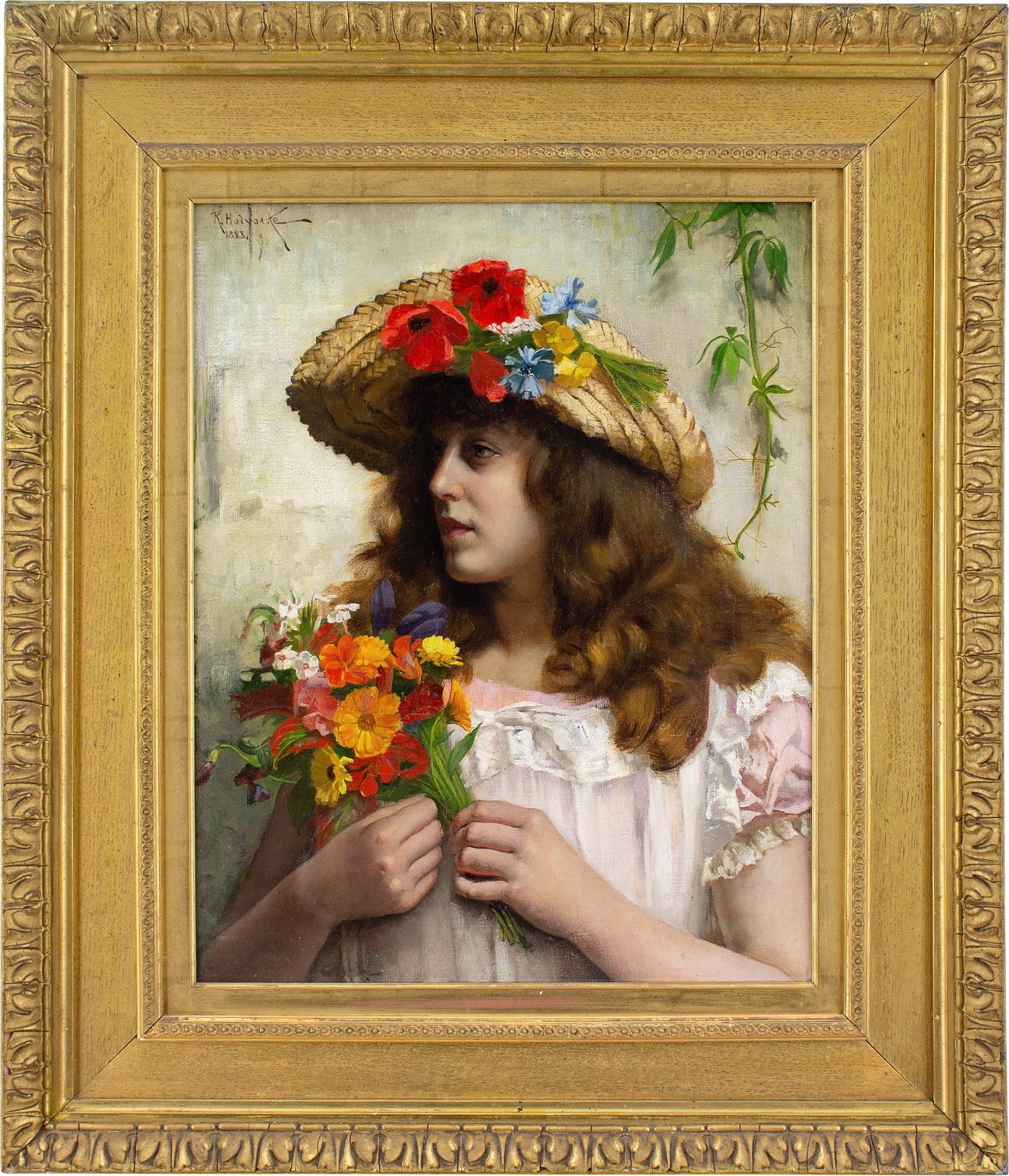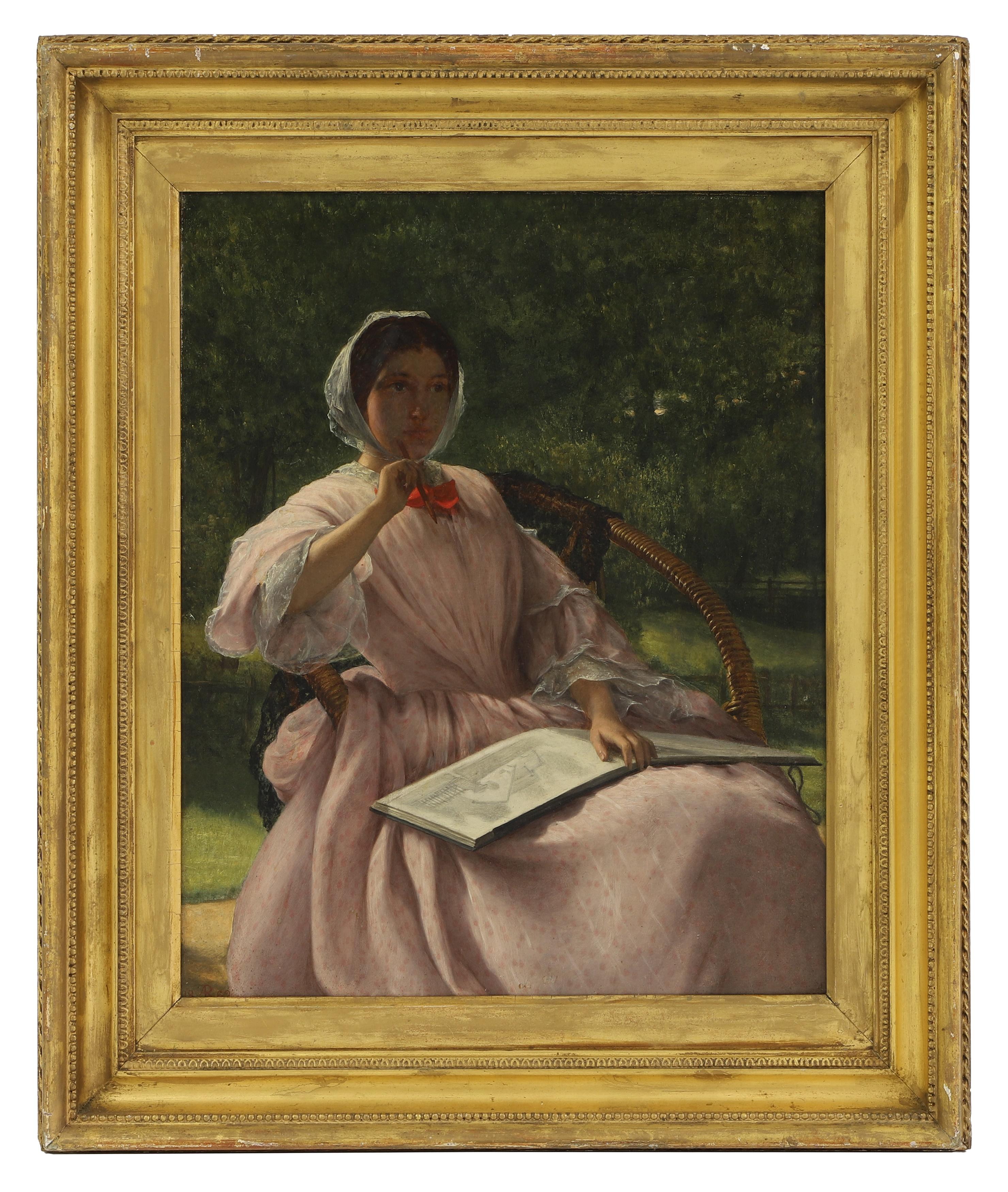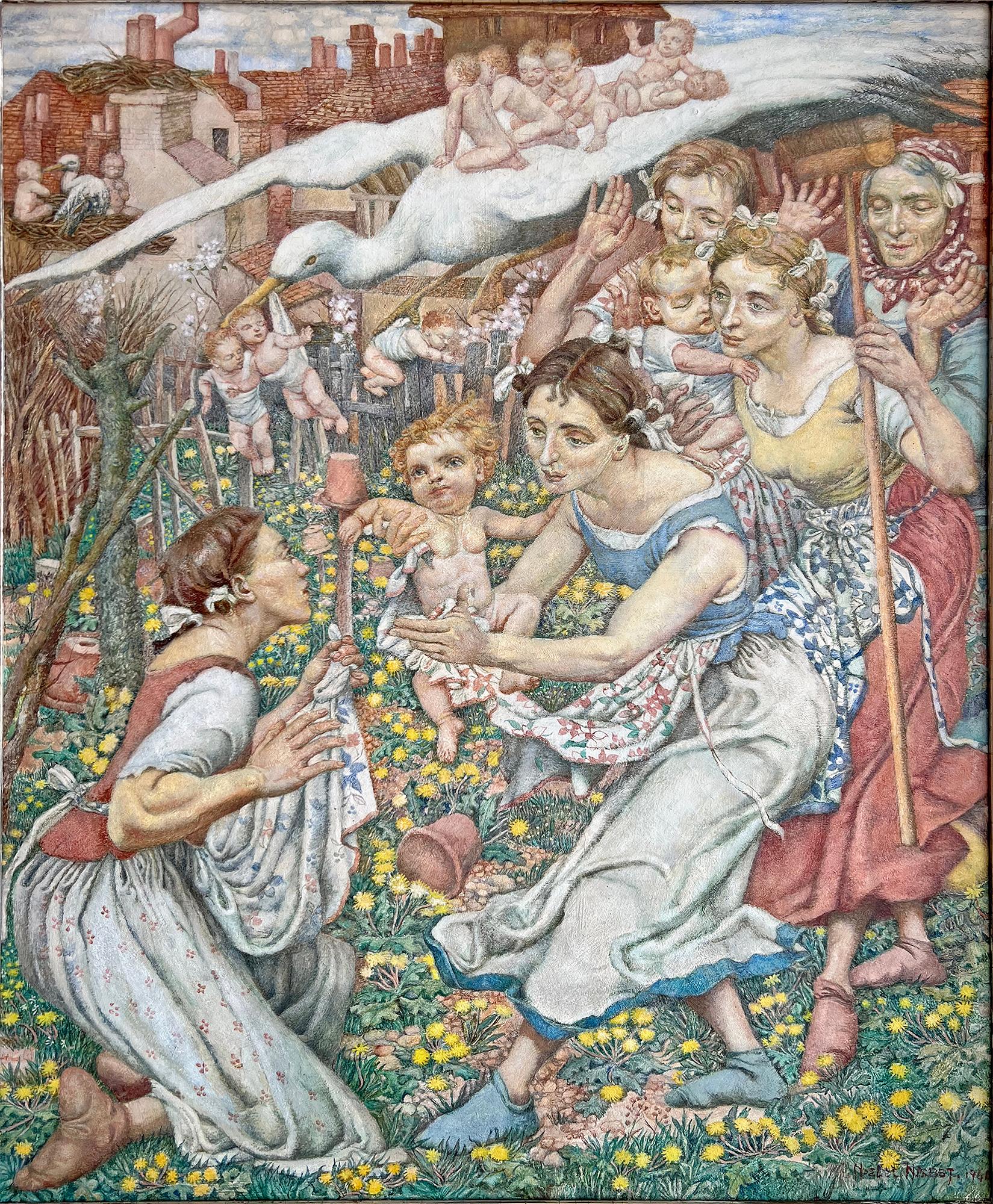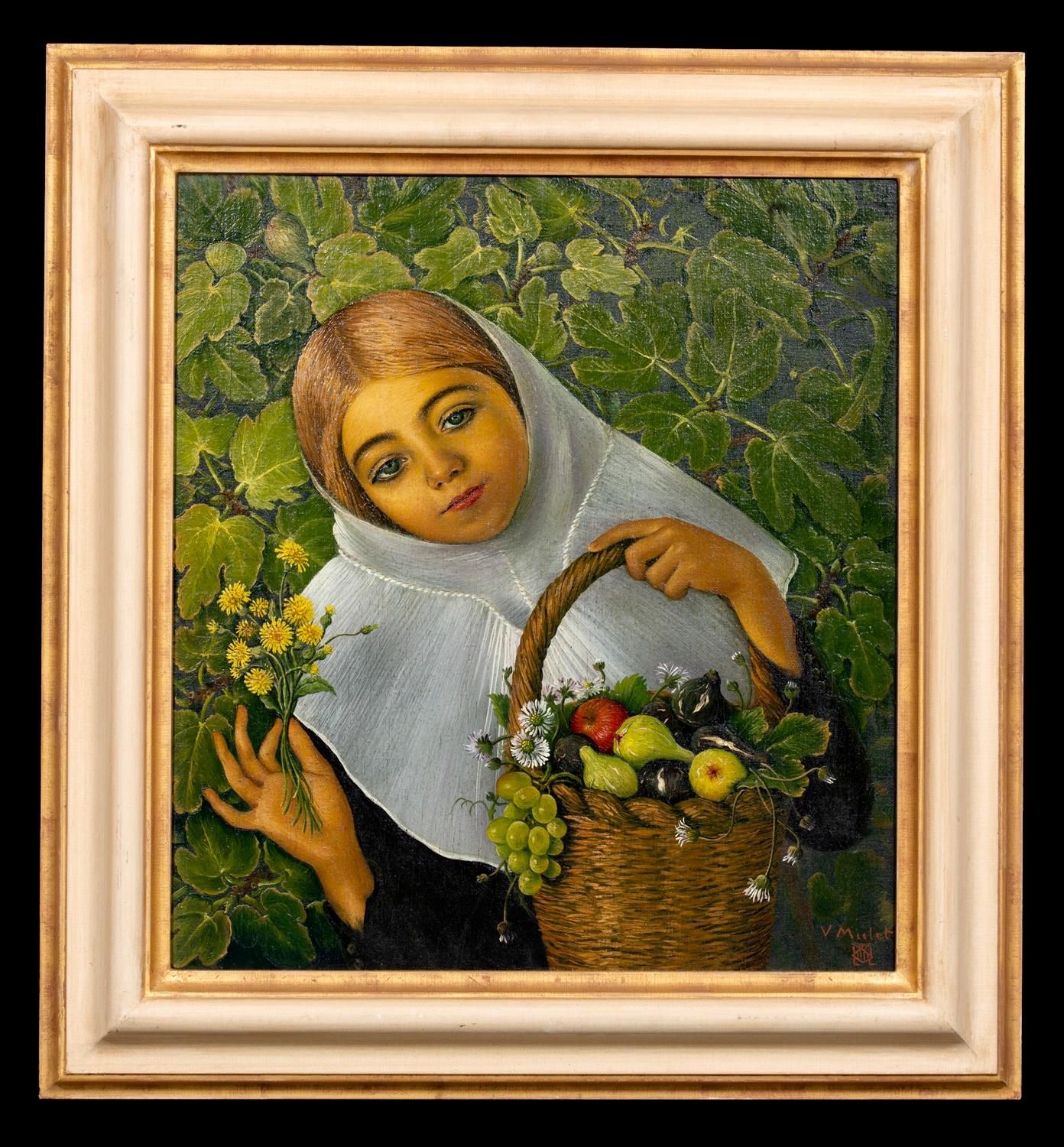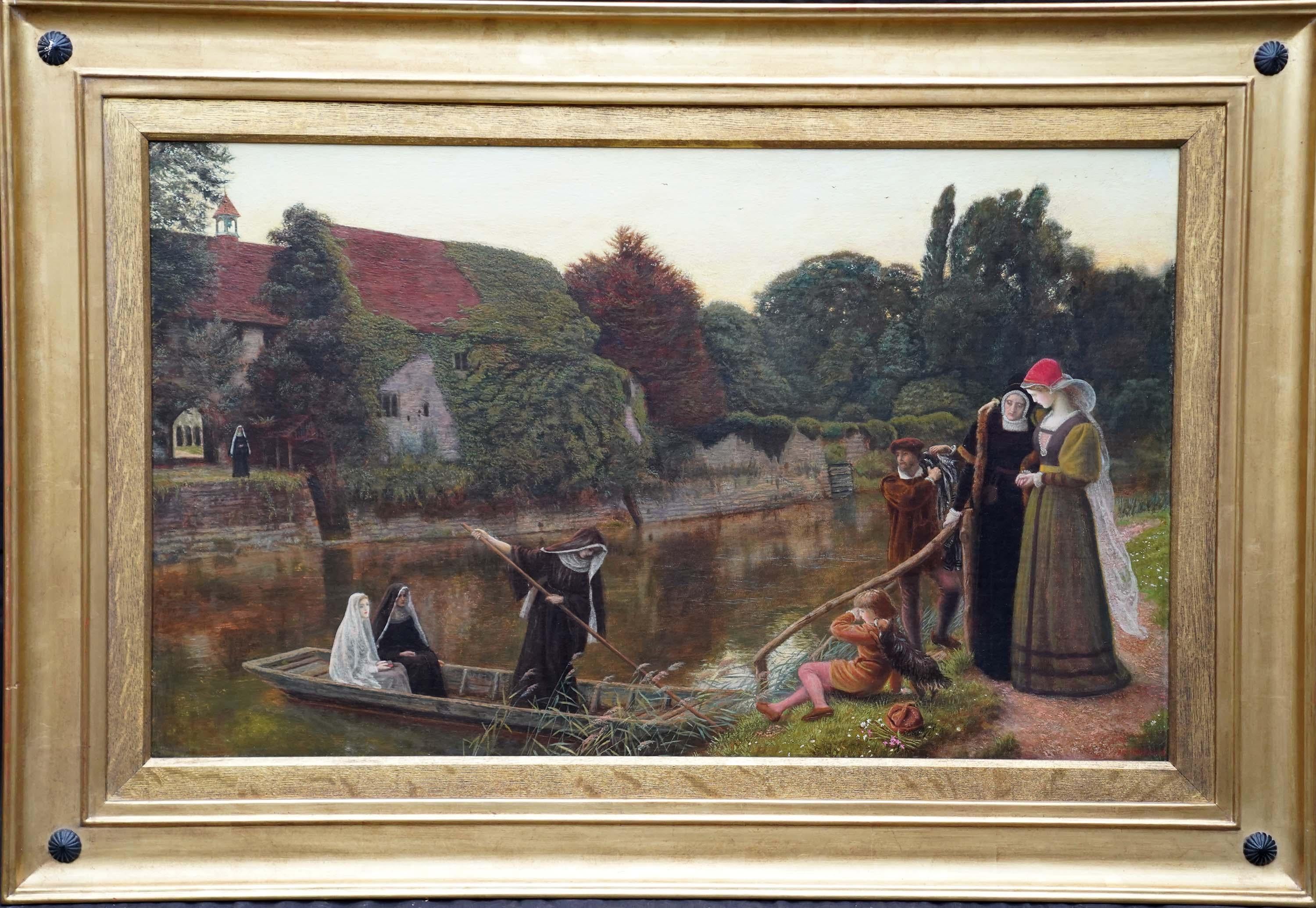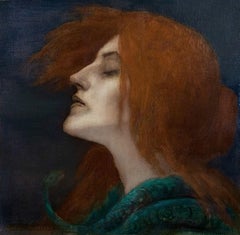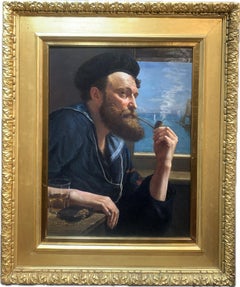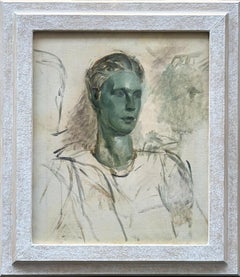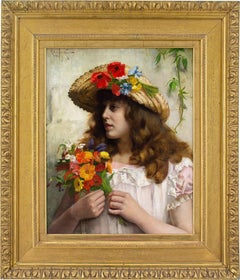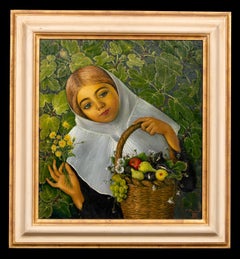Items Similar to Self Portrait, 19th Century Pre-Raphaelite Oil Painting
Want more images or videos?
Request additional images or videos from the seller
1 of 3
19th century British SchoolSelf Portrait, 19th Century Pre-Raphaelite Oil Painting
About the Item
Oil on canvas
Image size: 9 1/4 x 7 inches (23.5 x 18 cm)
Original pierced gilt frame
This wonderful Pre-Raphaelite self-portrait contributes to the artistic tradition of representing one's self through visual means, a tradition that stretches back to the time of Ancient Egypt.
Throughout the course of art history self-portraiture has remained a tried and true practice among leading artists. Self portraits can provide a fascinating glimpse into an artist's personality, professional ambition and their social success.
This self portrait is an exercise in technique as well as personal self-examination. The artist's soft eyes and relaxed body language welcome us into the scene we are presented with. The exquisite detail that the artist has achieved with the oil paint is captivating - look at the individually crafted hairs that punctuate the man's chin. This detail adds to the atmosphere of the scene, as does the warm lighting with which the artist has been lit. The light illuminates the artist's face as he turns to the viewer while creating a shadow across his jawline. A glowing aura is also formed around his figure, allowing the artist to exude a stage-like presence.
- Creator:19th century British School
- Dimensions:Height: 9.25 in (23.5 cm)Width: 7 in (17.78 cm)
- More Editions & Sizes:1 of 1Price: $7,318
- Medium:
- Movement & Style:
- Period:
- Condition:
- Gallery Location:London, GB
- Reference Number:1stDibs: LU52410975462
About the Seller
5.0
Gold Seller
Premium sellers maintaining a 4.3+ rating and 24-hour response times
Established in 2007
1stDibs seller since 2014
80 sales on 1stDibs
Typical response time: 4 hours
- ShippingRetrieving quote...Shipping from: London, United Kingdom
- Return Policy
Authenticity Guarantee
In the unlikely event there’s an issue with an item’s authenticity, contact us within 1 year for a full refund. DetailsMoney-Back Guarantee
If your item is not as described, is damaged in transit, or does not arrive, contact us within 7 days for a full refund. Details24-Hour Cancellation
You have a 24-hour grace period in which to reconsider your purchase, with no questions asked.Vetted Professional Sellers
Our world-class sellers must adhere to strict standards for service and quality, maintaining the integrity of our listings.Price-Match Guarantee
If you find that a seller listed the same item for a lower price elsewhere, we’ll match it.Trusted Global Delivery
Our best-in-class carrier network provides specialized shipping options worldwide, including custom delivery.More From This Seller
View AllThe Blue Headdress, Group Portrait Orientalist Oil Painting, Signed and Dated
By Emile Deckers
Located in London, GB
Émile Deckers
1885 - 1968
The Blue Headress
Oil on canvas, signed lower left, inscribed and dated "Algers, 1958"
Image size: 26 x 33 inches (66 x 84 cm)
Hand made Orientalist gilt f...
Category
1950s Portrait Paintings
Materials
Canvas, Oil
Lilith and the Snake, Oil on canvas femme fatale mythical portrait, Signed
Located in London, GB
Oil on canvas, signed lower left
Image size: 16 x 15 3/4 inches (40.5 x 40 cm)
Original gilt frame
Provenance
From the estate of the prominent art collector Leon Zielinski
This is ...
Category
Early 20th Century Portrait Paintings
Materials
Canvas, Oil
Sailor Smoking a Pipe
By Arthur David McCormick
Located in London, GB
Sailor Smoking a Pipe
Arthur David McCormick
Oil on canvas
Image size: 19 x 25 1/2 inches (48 x 65 cm)
Contemporary frame
Arthur David McCormick (1860–1943) was a notable British illustrator and painter, renowned for his landscapes, historical scenes, naval subjects, and genre scenes. Born in Coleraine, County Londonderry, he pursued his education at the Royal College of Art in London from 1883 to 1886.
McCormick’s career was marked by his contributions to various illustrated magazines, including the English Illustrated Magazine and the Illustrated London News. He participated in significant expeditions, such as Sir Martin Conway’s journey to the Karakoram Himalayas in 1892 and Clinton T. Dent’s expedition to the Caucasus Mountains in 1895. His illustrations from these travels were featured in Conway’s book “Climbing and Exploration in the Karakoram-Himalayas” (1894) and his own publication “An Artist in the Himalayas” (1895).
Throughout his career, McCormick illustrated nearly thirty books, focusing on travel and adventure themes. Some of his notable works include illustrations for Edgar Allan Poe’s “Tales of Mystery and Imagination” (1905) and Henry Newbolt’s “Drake’s Drum and Other Songs of the Sea” (1914). He was also a regular exhibitor at the Royal Academy from 1889 to 1938.
Navy Cut Sailor Work...
Category
20th Century English School Portrait Paintings
Materials
Canvas, Oil
Portrait of a Young Man Oil Painting Celebrated 20th Century Artist
By Oliver Messel
Located in London, GB
Oliver Messel
1904 - 1978
Portrait of a Young Man
Oil on canvas, signed and dated 'Oliver Messel 1930' (on the stretcher)
Image size: 30 x 25 inches (76.2 x 63.4 cm)
Original frame
Oliver Messel was born to Leonard and Maud Messel, née Sambourne, on the 13 January 1904 and was the youngest of three children. The family moved to Nymans, the Messel family home in Sussex, from nearby Balcombe in 1915. The house remained in the family until 1953 when it was bequeathed to the National Trust, following a fire in 1947 which destroyed a large portion of the house.
The Messels originated from a line of German Jewish bankers on Leonard’s side, however, both family lines boast a number of artistic influences, including Maud’s father. Maud was brought up at 18 Stafford Terrace, Kensington (now known as the Linley Sambourne House Museum), amongst collections of antique porcelain and eighteenth-century furniture, and with a host of artistic visitors such as Henry Irving and Oscar Wilde.
Oliver’s own upbringing appears to be influenced by his mother's, as the Messel family were also affiliated with artists and writers and were keen collectors of art, filling their home with textiles, paintings and collections of European and Asian fans from travels abroad. It was amongst such treasures that Oliver, Anne and Linley spent their childhood, in addition to the beauty of Nyman’s extensive gardens.
Oliver was schooled at Eton but rather than going up to university was encouraged by family friends, gallery owner Archie Propert and painter and sculptor Glyn Philpot, to attend art school. In 1922 he enrolled at the Slade School of Fine Art in London, where he studied under Henry Tonks. Here, he met the artist Rex Whistler with whom he remained firm friends until Whistler’s death in WW2.
Upon leaving the Slade in 1924 Oliver was apprenticed to the studio of portrait artist John Wells, where he learnt various Old Master painting techniques, and met artists such as Jacob Epstein, Augustus John and William Orpen.
Whilst at the Slade Oliver developed his interest in Papier Mâché masks, a pastime popular amongst many art students at the time. Whilst apprenticed to artist John Wells several of Oliver’s masks were exhibited at the Claridge Gallery, London, alongside pieces by Whistler and other young artists. These were seen by Serge Diaghilev, director of the Ballet Russes, and Charles B. Cochran, a theatrical producer, both of whom made Oliver offers of work.
His first job in the theatre was creating masks for the Ballets Russes’ Zéphyr et Flore, 1925, designed by the French artist Georges Braque, followed by numerous musical revues for Cochran, including Wake Up and Dream!, 1929, with music by Cole Porter. It was during these revues, working with Porter and Noel Coward, that Oliver also began to design headdresses and costumes. In 1932 he was rewarded with his first full commission to design both costume and sets for Helen!, directed by Max Reinhardt. The production design is still celebrated today for its innovative approach and ground-breaking ‘white on white’ aesthetic, which referenced ‘Greek temples, Rococo drapes, Baroque colonnades and Louis XIV carousels’.
The success of Helen! led to further offers within the theatre including Reinhardt’s version of A Midsummer Night’s Dream at the Old Vic in 1937, starring Vivien Leigh as Titania and Robert Helpmann as Oberon, the Jean Cocteau play The Infernal Machine in 1940, and Christopher Fry’s translation of Jean Anouilh’s Ring Round the Moon, 1950.
One of Oliver’s best-known productions during this period was the Russian ballet The Sleeping Beauty, performed by Sadler’s Wells Ballet in 1946 at the Royal Opera House, Covent Garden. Encompassing over 200 costumes and four set changes, Oliver’s romantic designs were celebrated for bringing colour back to post-war London, and variations on his designs are still used today. Additional designs for the ballet included Comus in 1940, for which he was released from war duties, and Homage to the Queen, choreographed by Frederick Ashton and performed in 1953 for the Queen’s coronation.
His first opera was in 1940 for Mozart’s Die Zauberflöte at the Royal Opera House, followed by a series of productions at the newly founded Glyndebourne Opera House in Sussex, for which Oliver also designed the proscenium arch. He triumphed in 1956 designing a season of four different productions for their Mozart bicentennial, also providing illustrations for the programme covers.
His popularity also spread beyond theatre to film, were he worked on over eight different feature films including Romeo and Juliet, 1936, directed by George Cukor. During a three-month research trip to Italy Oliver collected over 3,000 reference images including postcards of artwork by Piero della Francesca, Giovanni Bellini and Leonardo da Vinci, along with prints and photographs of textiles and architectural features.
A production of Gabriel Pascal’s Caesar and Cleopatra, 1946, starring Vivien Leigh and Claude Rains, was celebrated for Oliver’s ability to recreate the opulence and luxury of ancient Egypt under the constraints of wartime rationing. Such was his skill that Vivien Leigh in a letter to Oliver declared that “I have of course told Pascal that nobody in the world must do the costumes except you.” He was later nominated for an Academy Award for his work on his final film Suddenly, Last Summer, 1959; an adaptation of Tennessee Williams’ American Southern Gothic mystery.
Having started his artistic career as a portrait apprentice, capturing the faces of family and friends, Oliver continued to develop this practice until the end of his life. His style is said to have been influenced by Glyn Philpot, the Messel’s family friend who encouraged Oliver from an early age in his pursuit of art and design. His most prolific period came in the 1950s during which he produced over 50 portraits, which were shown in exhibitions in New York, London and Barbados.
The exhibitions included both well-known faces and anonymous sitters captured on Oliver’s travels, and a number of these works have entered private collections. He continued to paint after moving to the Caribbean in 1966, capturing society figures and the rich and famous including fashion designer Carolina Herrera and Bianca Jagger. His style remained unchanged throughout his career, using the same soft painterly strokes and subtle palette as in his theatre designs.
By far his greatest contribution in addition to theatre and film was Oliver’s interior and architectural designs.
Another, much celebrated commission included Rayne shoe shop in Old Bond Street, where he created jewel-like interiors using the same practice of scaled models as his set designs. Other notable interior designs include those for Norwich and Bath Assembly Rooms, Flaxley Abbey in Gloucestershire, Rosehill Theatre in Cumbria and the Reader’s Digest offices in Paris.
However, upon moving to Barbados in 1966, Oliver embraced a new career envisioning architectural concepts for private houses, hotels and public buildings, utilising his experience with interior design to furnish them with bespoke items of furniture and textiles. His first project was Maddox, the deserted eighteenth-century plantation house bought by himself and his partner Vagn Riis-Hansen in 1964. The existing building and gardens were remodelled to Oliver’s designs embracing an inherent theatricality with views out to sea. These were framed by terraces and verandas which extended out from the living rooms creating what is often referred to as a Caribbean style of ‘indoor-outdoor’ living. For the woodwork he used a shade of green that is now known as ‘Messel green’ and often associated with the island of Barbados.
Oliver was born into a wealthy family; he travelled extensively and was exposed to art and culture from a young age. A privileged youth, his name is often mentioned amongst the ‘Bright Young Things’, for whom costume parties at country houses and jaunts to Europe on a whim became a thing of fable. This informal group included people such as Cecil Beaton (a life-long friend whom Oliver first met at Eton), Lord Berners, Noel Coward, John Betjeman, Harold Acton, Nancy Mitford, Edith Sitwell, Stephen Tennant...
Category
20th Century Modern Portrait Paintings
Materials
Canvas, Oil
Self Portrait
By Gerald Goddard Jackson
Located in London, GB
Gerald Goddard Jackson
1878-1941
Self Portrait
Oil on canvas
Image size: 23½ x 19½ inches
Original frame
Jackson was born at Duddington, Northamptonshire on 5 March 1878. He enrolled at the Slade School of Art in 1893 where he studied alongside fellow students Wyndham Lewis, Orpen, Gertler, Nash and Nevinson. He left the Slade in 1899 in order to travel to Canada, USA and Mexico, spending three years in Italy.
In 1911, he joined the Army. Upon the outbreak of the First World War, his battalion was sent to France. He was captured in 1916 and was held at various German prisoner of war camps, largely at Schwarmstedt in Saxony. Whilst in captivity he befriended the poet Frederick William Harvey...
Category
20th Century Portrait Paintings
Materials
Oil, Canvas
Portrait of a Gentleman Commoner at Oxford, 18th Century Oil on Canvas
By James Northcote b.1746
Located in London, GB
James Northcote
Portrait of a Gentleman Commoner at Oxford
Oil on canvas
Image size: 30 x 25 inches (76 x 63.5 cm)
Original gilt frame
This painting is a comparatively rare example ...
Category
18th Century English School Portrait Paintings
Materials
Canvas, Oil
You May Also Like
Rowland Holyoake, Portrait Of A Girl With Wildflowers
Located in Cheltenham, GB
This charming late 19th-century oil painting by British artist Rowland Holyoake (1861-1928) depicts a girl carrying wildflowers while wearing a straw hat decorated with the same. It ...
Category
1880s Pre-Raphaelite Portrait Paintings
Materials
Canvas, Oil
Large Victorian Signed Oil Painting Lady Artist Seated Sketching in Garden 1862
Located in Cirencester, Gloucestershire
The Female Artist Sketching in the Garden
by Arthur Rankley (British, 1819-1872)
signed and dated 1862 with monogram
oil painting on canvas, in antique period gilt frame
canvas: 24...
Category
Mid-19th Century Pre-Raphaelite Figurative Paintings
Materials
Canvas, Oil
Pre-Raphaelite Style Painting of Mothers and Babies in WWII
Located in Miami, FL
Babies are falling from the sky and not bombs. British female artist and illustrator Noel Laura Nisbet makes a passionate twist to the reality of En...
Category
1940s Pre-Raphaelite Figurative Paintings
Materials
Canvas, Oil, Mixed Media, Tempera
'Gathering fruit and flowers' by Vicente Mulet y Claver (1897 – Valencia – 1945)
Located in Knokke, BE
Vicente Mulet y Claver
1897 – Valencia – 1945
Spanish Painter
'Gathering fruit and flowers'
Signature: signed lower right 'V Mulet' and with the artist's monogram, circa 1930
Mediu...
Category
Early 20th Century Pre-Raphaelite Portrait Paintings
Materials
Canvas, Oil
The Convent Boat - British Victorian Pre-Raphaelite art religious oil painting
Located in London, GB
This stunning British Victorian Pre-Raphaelite oil painting is by noted artist Arthur Hughes. It was painted circa 1874 and has extensive provenance. The composition is of a novice n...
Category
1880s Pre-Raphaelite Portrait Paintings
Materials
Oil
Portrait of a Girl Holding Wool - British Edwardian female portrait oil painting
Located in London, GB
This beautiful British Edwardian portrait oil painting is by noted and much exhibited female artist Maud Marion Wear. Wear trained at the Royal Academy Schools in London for five yea...
Category
Early 1900s Pre-Raphaelite Portrait Paintings
Materials
Oil
Recently Viewed
View AllMore Ways To Browse
1 19th Century
British Traditions
Antique Exercise
Fine 17th Century Old Master Portrait
Painted Eighteenth Century Portrait
Lady Jane
Mary Stuart
Oval Old Masters Paintings
18th Century Child Portrait
Admiral Portrait
Gilbert Oil Portrait
Studio 54 Invitation
Old Abbey
Portrait Of Nobleman
17th Century Portrait Spain
17th Century Spanish Portrait
18th Century Portrait Queen
Galley Ship
